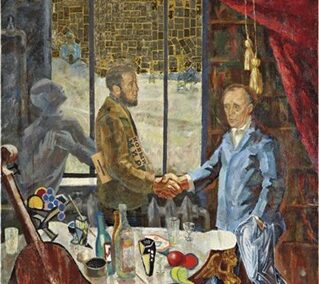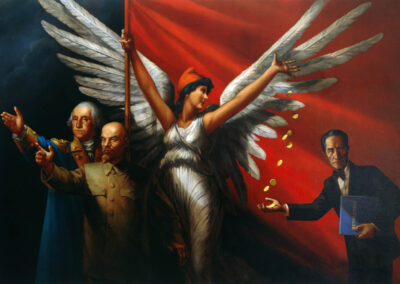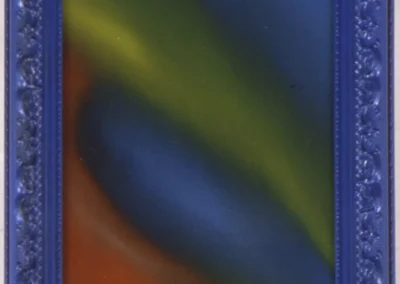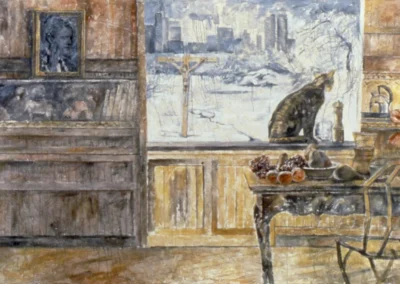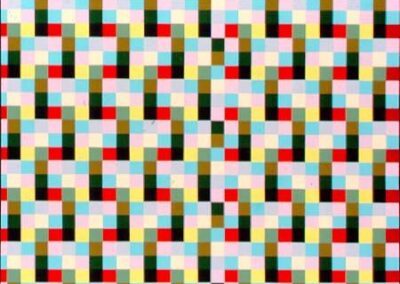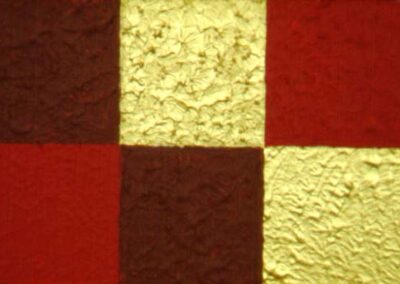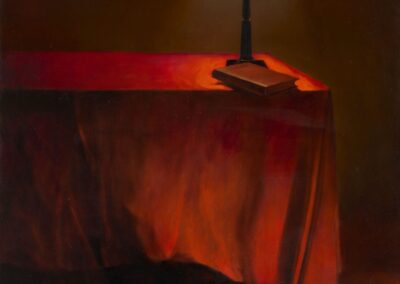Our next Artists You Need To Know are Komar and Melamid.
The Russian born conceptual artists Vitaly Komar (born 1943) and Alexander Melamid (born 1945) have – for over 35 years – created artworks where they function as a singular entity, as their process is collaborative at an ideological level : “even if only one of us creates some of the projects and works, we usually sign them together. We are not just an artist, we are a movement.”
From artnet : “Once dubbed “exasperating expatriates” for their relentless, wry mockery of the social, political, and artistic systems of the former Soviet Union, Vitaly Komar and Alex Melamid met as art students in Moscow, and teamed up in 1965. They worked together until 2004, creating an outpouring of paintings, sculptures, installations, performances, public projects, photographs, music, and poetry, charged with keen criticisms of Communism, consumerism, the art market, and other human excesses.”
There is a video about the body of work that includes the final three images from the gallery above (which are from the series Catalogue of Super Objects — Super Comfort for Superpeople, 1976) which can be seen here. Like much of their work, it offered a sarcastic – and somewhat caustic – take on official Soviet rhetoric about citizens.
They met during their attendance and graduation from both the Moscow Art School (1958 to 1960) and the Stroganov Institute of Art and Design (1967).
Komar and Melamid are the founders of the movement they call SotsArt (СоцАрт) : this is described as “a form of Soviet Nonconformist Art that combined elements of Socialist Realism and Western Pop Art in a conceptual framework that also references Dadaism.”
While still in the USSR, they were expelled from the Soviet Artist Union In 1973 and in 1974 were arrested during a performance work and their artworks (among other noncomformist artists) were destroyed. This precipitated their leaving the USSR, eventually settling in New York City in 1978 :t heir first show in the West was at the Feldman Gallery (New York, 1976), and their first individual museum show was at the Hartford Athenaeum (Harford, USA, 1978).
The images below are from their Nostalgic Socialist Realism series parodying – though they might say it is more ‘realizing’ – socialist realism and the cult of Stalin that had informed art in the former USSR.
“No one would ask of life, “Is it all serious or all a joke?” because tragedy and comedy coexist in one life. You cannot separate and say it is all one ore all the other. It is the same with this work, with all our work: it is serious and humorous at the same time.”
The images below are from the American Dreams series that brings Komar and Melamid’s irreverent humour – but always well executed and engaging, in its acerbity – to the mythologies of the United States, in a manner similar to their better known works that lampooned similar ideologies in the former Soviet Union : “Having lived half a lifetime in Moscow and half a lifetime in New York, I can refer to mass culture in the Soviet Union as the ‘advertising of ideology’, while in the West it is the ‘propaganda of consumerism’.” (Vitaly Komar)
Komar and Melamid are also well known for their People’s Choice series, which was a project that spanned from 1994 to 1997 and encompassed 11 countries. Although sounding somewhat facile, it was an endeavour that the artists collaborated with the Dia Art Foundation to produce.
The artists commissioned polling companies in these countries (these included the United States, Russia, China, France, and Kenya) to poll people on what they wanted to ‘see’ in an art work. In a nod to their experience in the former Soviet Union, with the rhetoric around the proletariat and the ‘common’ person, and a somewhat ironic nod to their lives in the United States, the project was designed to imitate the American democratic process.
Komar elaborated that this is “our collaboration with various people of the world. It is a collaboration with [the] new dictator—Majority.” The process was also meant to change the artists role as a leader. Komar and Melamid believe that the broad public is an adequate judge of art, contrary to the historical precedence, much in the same way that the broad public in America is entrusted with electing the President. It is a new type of leader, one that asks questions, instead of a dictator. Melamid said, “Picasso mimicked Stalin, so we try to mimic Clinton.” (from here)
Unlike much of their other perhaps sarcasm – laden works which are executed in a manner that displays their artistic acumen and engage the viewer (while, perhaps, later horrifying them in terms of conceptual commentary), the artists stated that they were not overly focused on viewers actually enjoying the works in this series. Komar stated that the People’s Choice series should “provoke thoughts of free will versus predetermination.” Elaborating further, Komar said, “In our early work, we arrived at [the] definition of freedom that entailed being free from individual cliches, being free to change intonations and styles. Individuality lost its stability and its uniqueness. Now we are searching for a new freedom. We have been traveling to different countries, engaging in dull negotiations with representatives of polling companies, raising money for further polls, receiving more of less [the] same results, and painting more or less [the] same blue landscapes. Looking for freedom, we found slavery.” The reference to Orwell’s seminal book 1984 – with that last comment – is intentional, in the multi layered irreverence that is a stream through all of these artists’ career. Their frequent rei-maginings of Stalin in their socialist realist inspired art also play upon Orwell’s parody – or inspiration – of Stalin as Big Brother.
A musical version of The People’s Choice was also produced by Komar and Melamid, in collaboration with composer Dave Soldier : The Most Wanted Song and The Most Unwanted Song can be found online.
Much more about this project can be seen here.
A brief listing of important exhibitions of the artist’s work include the Museum of Modern Art (Oxford, 1985) and Museum of Decorative Art in the Louvre (Paris 1985-1986); NGBK (Berlin, 1987); Brooklyn Museum of Art (New York, 1989); Museum of Modern Art (Cologne, 1997); Kunsthalle Vienna (Vienna, 1998); Venice Biennial (Venice, 1999); Kawamura Memorial Museum of Art (Japan, 2023); and the Yeshiva University Museum (New York, 2023-2003).
Komar and Melamid’s artworks can be found in the collections of the Guggenheim Museum (New York), Metropolitan Museum of Art (New York), Whitney Museum of American Art (New York), Museum of Modern Art (New York), Victoria and Albert Museum (London), Stedelijk Museum (Amsterdam), Albertina (Vienna), Museum Ludwig (Cologne) and the San Francisco Museum of Art.
The duo did reunite in 2023 for a massive retrospective, revisiting some of their sardonic and evocative ideas, not the least being where they fit in the larger conversation about art history : “There’s a machine which is called History of Art, which is a structure. And artist fits in this only because he or she is needed for this structure. If for example the History of Art needs some parallel lines, there is an individual who makes parallel lines. And this individual fits into this machine which works by itself; it doesn’t care about people or anything else, it just goes by itself.”
The curator Andrei Erofeev asserts that Komar and Melamid were “the first world-class artists who emerged in the Moscow art underground of the 1970s [and the] first to be globally recognized as the successors of the Russian historical avant-garde [such as Malevich or Kandinsky] and colleagues of Western pop artists and conceptualists”. Erofeev also states that Komar and Melamid “brought the spirit of political parody, mockery, playing with art styles, visual languages of modernism, kitsch and totalitarianism into Russian culture”. (from The Art Story)
More about Komar and Melamid can be seen here and here. Their practice, as a duo, has been nothing if not prolific, and this is just an overview of their many projects.


